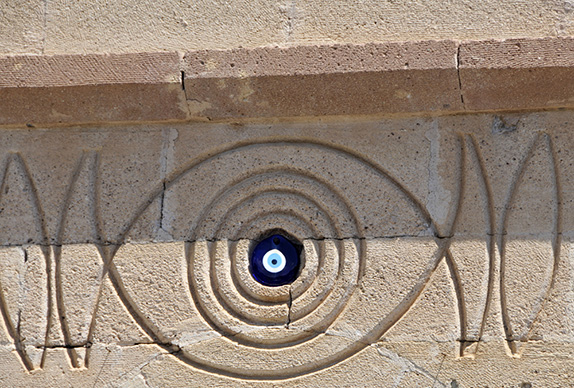 (The “evil eye” adorns houses throughout Turkey, warding off danger. Images by Margaret Randall.)
(The “evil eye” adorns houses throughout Turkey, warding off danger. Images by Margaret Randall.)
Place is essential to who we are, how we think and feel, our connections with others, contributions, and expectations. More than a destination, where we are born or choose to make our home shapes everything about us. So does the history that haunts us. In Turkey, the “evil eye” can be seen everywhere. It reminds us of danger’s presence even as it protects. Complexity is the name of the game.
One of the first things you hear about Istanbul is that a part of the city is in Asia, the other in Europe: a city that straddles two continents. The historic and economic centers lay on the European side, while Asian Anatolia, stretching out from one shore of the busy Bosphorus River, has less administrative importance but contains equally fascinating streets, squares, markets, mosques and minarets. The city of Istanbul has also been known as Byzantium and Constantinople. Ankara is the capital, but nothing rivals Istanbul for the richness of its history or cultural diversity.
Traveling to Turkey, one learns that the entire country is a metaphor for a bridge—between cultures, languages, arts, foods, and conflicting takes on the past as well as the future. For one thing, it is bordered by eight others: Bulgaria, Greece, Georgia, Armenia, Iran, the Azerbaijani exclave of Nakhchivan, Iraq, and Syria. One has only to think about what has gone on in any of those countries over the past half century, to understand its compelling geostrategic significance. The US, after all, has its geopolitical and cultural hands full with its Canadian and Mexican borders (think universal healthcare to the north, an ominous border to the south). Then there are the bodies of water that lap Turkey’s shores: the Mediterranean, Aegean, Black Sea and Sea of Marmara. Contradictions abound, as do surprising ways of embracing them.
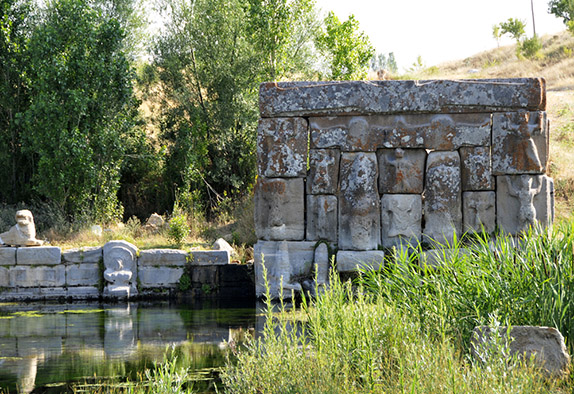 (Hittite monument to water)
(Hittite monument to water)
Simply hitting the high points, Turkish history passed from the Paleolithic to the Hittites and on through Alexander the Great; Persian, Greek and Roman rule; and the Byzantine and Ottoman empires—all before World War I. Mustafa Kemal Atatürk (1881-1938), Turkey’s first president and considered the father of the nation, is credited with bringing the country into modernity. He instituted economic and educational reforms, including women’s rights.
The Armenian holocaust of 1915 was, along with the Jewish holocaust in Europe, the event that coined the term used for mass genocide. Atatürk admitted to that dark page in Turkish history, and punished many of those responsible. Yet most Turks today still will not acknowledge the event, preferring to rewrite the story than to face up to its painful shroud.
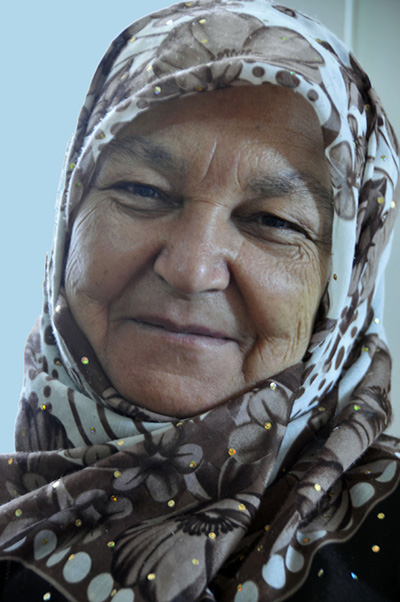
(Peasant woman)
But it isn’t only the decimation of Armenians that stains Turkish history. Less than a decade after the genocide, the country endured a forced population exchange with Greece. Some one and a half million Anatolian Greeks and 500,000 Muslims then living in Greece were removed from their homes and sent to the neighboring country. We know about forced deportation, having suffered it in our own Seminole Trail of Tears and the Navajo march to Bosque Redondo, among other shameful histories. Such travesties leave haunting holograms. In Turkey entire villages remain abandoned. Turkey’s unease with its Kurdish population and its refusal to recognize Cyprus can be traced, perhaps, to its failure to come to terms with a history of extreme nationalism.
Turkey is Baltic, yet vital to the US; a powerful force in Europe and yet not a member of the European Union. It is 85% Muslim but its women gained voting rights at the same time as men, and women in general enjoy more freedom than they do in most Muslim nations. The contradictions go on and on.
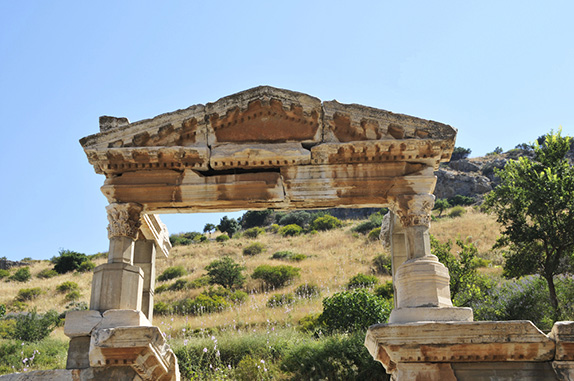 (An arch at Ephesus)
(An arch at Ephesus)
My own visit to Turkey embraced a string of surprises and contradictions. I had long wanted to visit 10th century Ephesus—especially what is left of its Celsus Library, and loved walking through its ruins. But I found I was more attracted to the smaller, more intimate, ruins at Perge. I had dreamed of the famed Blue Mosque and Hagia Sophia in Istanbul and, while both landmarks are exquisite, found I was more intensely interested their extraordinary architecture than in what they mean as sites of religious practice. Hagia Sophia, especially, is a remarkable engineering feat. Once the grandest church in the Christian world, and later a mosque, it is now a museum—with the largest dome in the world. This dome is carried on four pendentives that distribute its weight to the walls beneath.
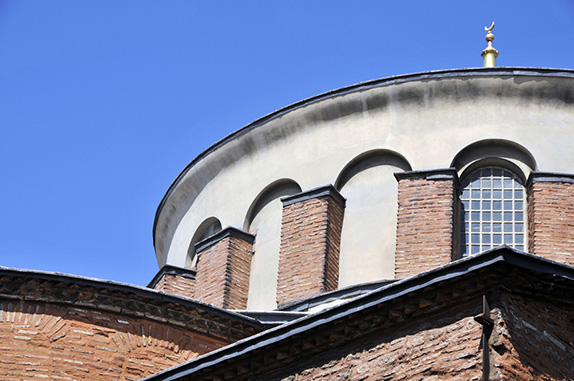 (Detail, Hagia Sophia)
(Detail, Hagia Sophia)
I had long been intrigued by pictures of Cappadocia, with its inhabited volcanic spires, but was equally captivated by a string of abandoned caravansarai, way stations where the camel trains stopped along the Silk Road. Before our trip, we poured over travel guides, all emphasizing the wonders of world-class monuments. Once there, we were more interested in out of the way side streets and high mountain villages. And, having sailed among Greece’s Aegean islands, we found Turkey’s Turquoise Coast more isolated and beautiful, and much less given over to tourism.
I want to write about Turkey with attention to place in its most profound sense. I want to evoke how deeply place surprised me there.
As a poet, I was excited to visit Konya, a city of approximately one million, where the mausoleum of Jalal ad-Din Muhammad Rumi, is located. Jalal ad-Din Muhammad Rumi was the Sufi mystic known simply as Rumi in the West. Rumi’s poetry is widely available in English translation. It is beloved as literature, and also for its life teachings, much in the manner of Sappho, Omar Khayyám, Suzuki and other imparters of wisdom from a variety of cultures.
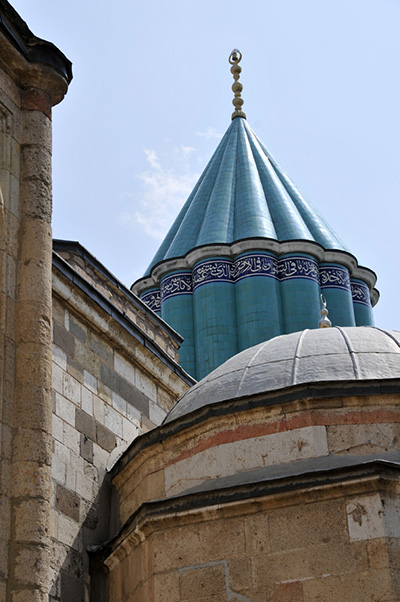
(Rumi’s mausoleum at Konya)
The mausoleum is part of a compound of related buildings surrounding a central courtyard. Immediately you realize this is not your typical tourist site. The place swarms with people, most natives from a variety of local ethnicities, whole families out for the day at a site important to them. Women unwrap picnic eats. Babies cry. One baby cried so long and insistently when we were there that I thought something serious must be wrong.
The architecture here is quite beautiful. A central tower is completely covered in turquoise tile. Turquoise has a special meaning in Turkey, much as it does in New Mexico—perhaps for similar reasons. I would have been happy to have stayed in that outside space, people-watching. But our destination was Rumi’s tomb, so we made our way to the main building’s entrance. Here we were asked to don blue paper booties, so as not to scratch or dirty the marble floor inside.
Almost as soon as we entered, I found it hard to breathe. Air seemed at a premium. Throngs pushed past statuary and sarcophagi, all extraordinarily ornate. Where was the simplicity Mevlevi’s order espoused? This had been the order’s main lodge, home of the famous whirling dervishes. I couldn’t wait to exit.
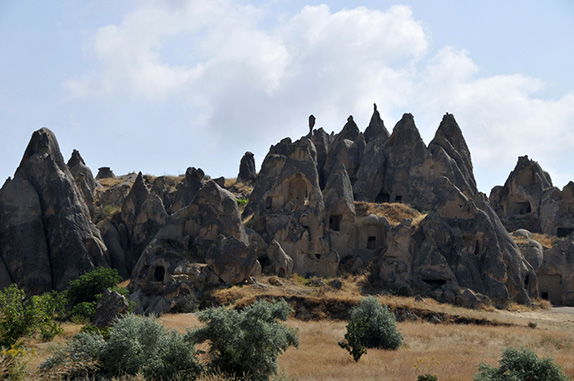 (Cappadocia landscape)
(Cappadocia landscape)
Later, in Cappadocia, I had the opportunity of witnessing a whirling dervish ceremony that connected me to the culture in a much more satisfying way. This wasn’t the usual exhibition number I’d seen in other countries where the ritual is sold to tourists, but an event we were permitted to attend if we agreed to do so respectfully. I don’t like religion, and wasn’t sure I wanted to go, but was very glad I had.
Held in a renovated caravansarai, rows of seats were arranged around three sides of a bare floor. Sufi whirling or spinning is a form of sama, physically active meditation. Dervishes (also called semazens) aim to reach the source of all perfection, or Kemal through abandoning one's ego or personal desires, by listening to the music, focusing on God and spinning one’s body in repetitive circles. The spinning is symbolic of the planets orbiting the sun.
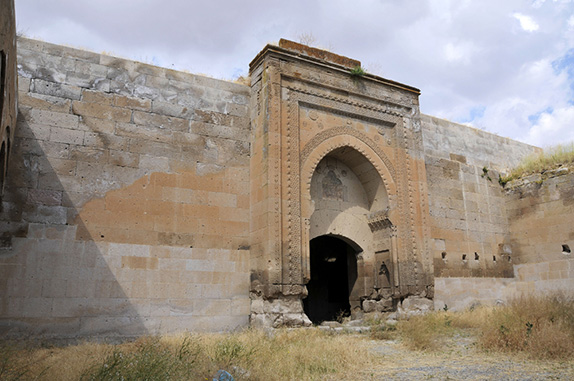 (Ancient caravansarai now in ruins)
(Ancient caravansarai now in ruins)
In the symbolism of the sema ritual, the semazen’s camel hair hat, called a sikke, represents the ego’s tombstone. His white shirt, or tenure, represents its shroud. By removing his black cloak, or hirka, he is spiritually reborn to the truth. At the beginning of the dance, by holding his arms cross wise, the semazen appears to represent the number one, testifying to God’s unity. While whirling, his arms are open. His right arm points to the sky, while his left, upon which his eyes are focused, is turned toward earth. In this way the semazen conveys God’s spiritual gift to those witnessing the ceremony. Afterward, through an interpreter, we had a chance to speak with one of the dervishes, to ask questions about his practice. He explained that he also whirls at home, sometimes with his wife and their children as apprentices. By day, this man is a pipefitter. I was moved by how forthcoming he was, and by how his religious practice is aimed at gifting others.
Who hasn’t seen pictures of Cappadocia? It is a place of volcanic formations hollowed out to house doves in small cotes, families in intricate configurations of rooms, even chapels from the Middle Ages richly painted with frescoes that can still be admired in only slightly tarnished glory. The underground chapels at Goreme are feasts for the eyes.
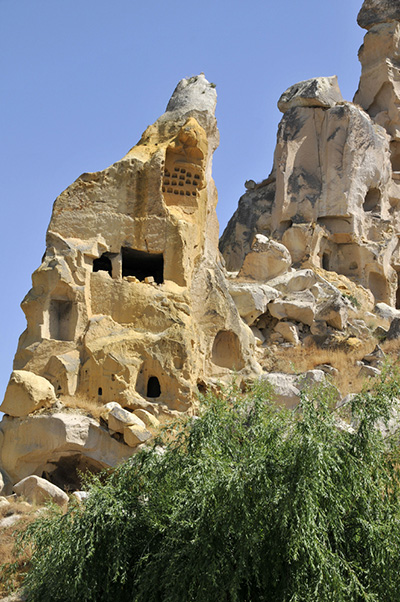
(Cappadocia, living in the rock)
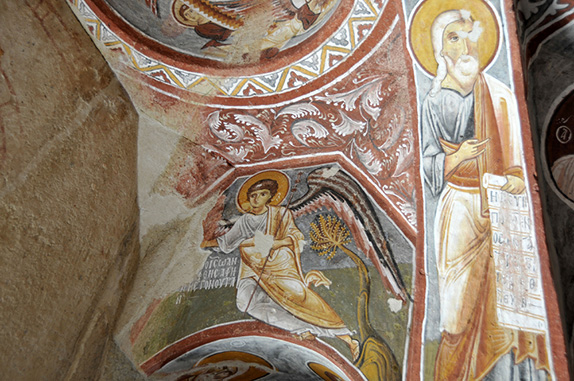 (Frescos inside Goreme chapel, Cappadocia)
(Frescos inside Goreme chapel, Cappadocia)
Cappadocia cannot fail to remind the New Mexican of the hidden treasure known as Tent Rocks, on Cocihti land between Albuquerque and Santa Fe. Except that where Tent Rocks is landscape, Cappadocia is habitat. Silhouettes of the whimsical land forms stretch for miles. Hiking among them is an experience. Terrain created by the same sort of movement of earth makes for very different places.
Although I delighted in everything about Cappadocia, I was particularly struck by a sight that reminded me of the Moqui Steps that one can see at Chaco and others of our own Ancestral Puebloan sites. It was a line of footholds, just beneath a ridge, moving across the land. It spoke to me of place with intention, how our ancestors moved from here to there. I imagined a Chacoan woman, perhaps carrying a baby on her hip, climbing Moqui steps to the mesa top; or maybe someone at Tsankawi whose repeated walking wore deep crevices into paths we still transit today. And I saw a woman in ancient Cappadocia trudging from foothold to foothold. Everywhere and in every time, I thought, we start out traveling with that which is beneath our feet.
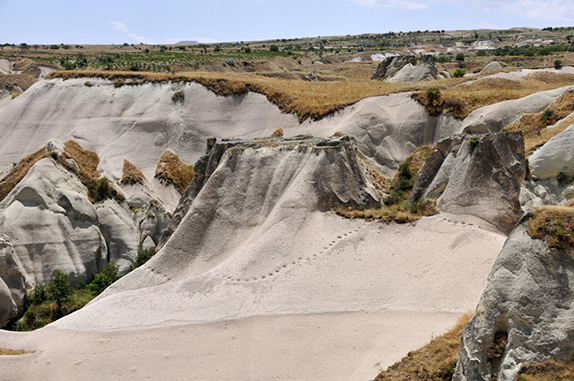 (Footholds in the rock)
(Footholds in the rock)
High in the mountains, in the interior of the country, lakes have long been a source of sustenance. In the tiny village of Budek, the men have fished for generations. Recently, however, the government seeded the lake with a particular fish it believed would create a healthier water environment. Instead, it did away with the fish that had provided the villagers of Budek with their livelihood. We arrived in town just as the sun was beginning to throw long slants of light through gathering clouds. We walked to the lake with our hosts so they could show us how few boats were tied up at their small dock, how their business had diminished. Ever resourceful, Budek is turning its attention to its fields of wheat, and the milk cows I saw being led back into barns.
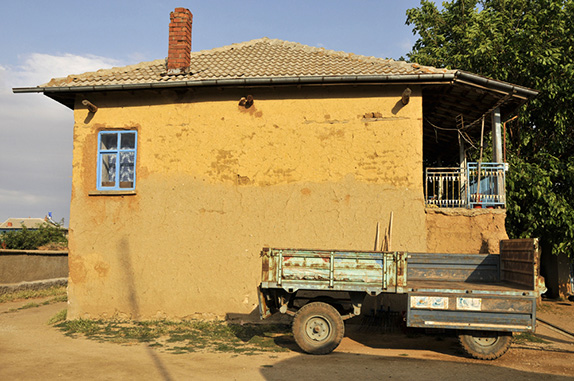 (Budek village, Sulieman’s house)
(Budek village, Sulieman’s house)
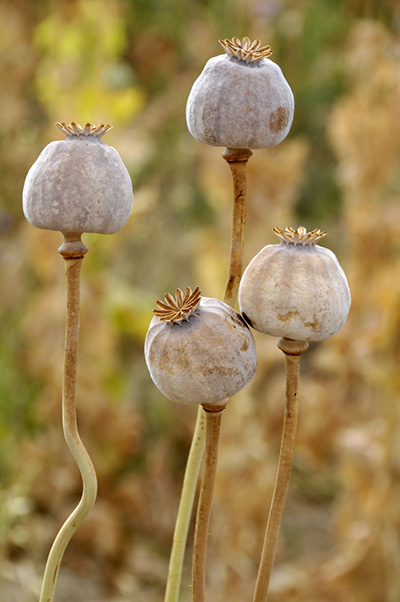
(Poppy bulbs)
We’d also seen a good deal of poppy plants border the road going into the village. “Only for the seeds,” several people said, clearly eager to dissuade us of any idea they might be producing opium. That night we had dinner with a local family, slept on their futons under piles of warm quilting (they spent the night with relatives), and shared breakfast the following morning. They served some of the most delicious homemade rolls I’d ever tasted, liberally sprinkled with poppy seeds. I asked for the recipe, and the woman who had baked them generously wrote it out. Even without measurements, I was able to reproduce fairly good copies when I got home.
Despite having to converse through an interpreter—none of us spoke Turkish nor did our hosts speak English—we learned about life in a Turkish mountain village in ways we never would have through books or films. What we got a sense of was place, their place: the hours they worked, what tastes were blended into their food, what they ate for breakfast, what their bedding felt like, how generations share space, and how life changes.
 (Budek village, family in front of their house)
(Budek village, family in front of their house)
The oldest generation in this particular family consisted of grandparents in their nineties. They made a brief appearance to welcome us, then retreated to their own house. In the next generation the de facto head of the family was Sulieman. He and his wife Nigar had three sons, each of whom had married a woman who had come to live with them. Nigar was covered from head to toe. Her daughters-in-law wore long skirts and headscarves. A fifteen-year-old cousin, who had come from the city to spend the summer, wore jeans and a bare midriff. Her hair was completely uncovered. I asked if her young age made the difference in her outfit, and was told “No, as the years pass women here tend to become more modern.”
After dinner and over breakfast the members of this family asked us about our homes, jobs, even our beliefs and preconceptions about their country. They made it easy for us to ask them about theirs. Duality shaped space everywhere we went. The famous Van cat, from the province of the same name, has one brown and one blue eye. We were startled the first time we saw one.
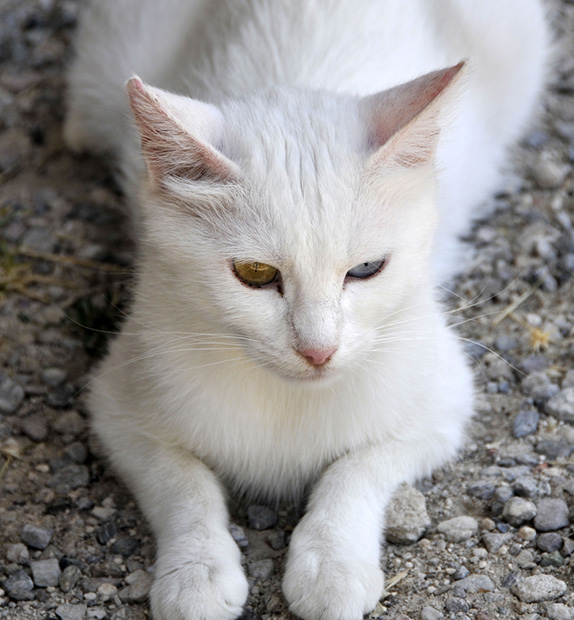 (Van cat, with one brown eye and one blue)
(Van cat, with one brown eye and one blue)
I am always interested in histories of travel and trade, and naturally wanted to know about the camel caravans that once passed through Turkey’s portion of the Silk Road. In and near Cappadocia we sometimes passed great abandoned buildings, obviously grand in their day. We stopped at one, and our guide broke the lock holding shut the gate at the massive front entrance. Inside, we wandered through a large courtyard bordered by rooms that once lodged the merchants who’d spend a night or two here before traveling on.
We learned that, in contrast with other countries along the long Silk Road, Turkey never charged a fee for passage through its territory. Rather, the caravansarai claimed a percentage of goods. Counting was important. An official was designated to control the trains and what they carried. Each camel master was asked to record and report his quantity of goods. Then the compound was locked for the night. The next morning, if anything was missing, no one would be allowed to leave until it could be accounted for. Safe passage included a safe place to spend the night, cooked food, and the assurance of guaranteed freedom from loss.
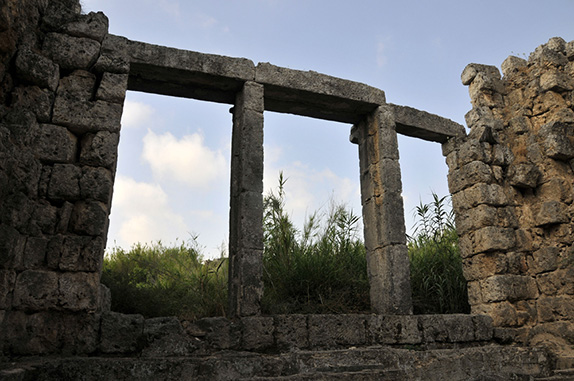 (Baths at Perge)
(Baths at Perge)
One of my favorite Turkish cities was Antalya. Its inhabitants manage a perfect marriage between the modern city and its ancient center, where vehicles larger than a small car are not allowed in the narrow winding streets. Hadrian’s Gate, at the entrance to this old section, is a marvel of architecture and speaks to me of its builder, one of my favorite historic figures.
Hadrian (76 to 138 AD) was a ruler who traveled widely in order to know his people, a military man with a preference for peace, a homosexual who didn’t hesitate to proclaim his love for the Greek youth Antinous, and a builder who left some of the greatest examples of architecture in his time. He was famous for his walls and gates. The gate in Antalya showcases a central track where chariots once passed. Today the deep grooves of their wheels in the stone are protected by a thick covering of glass, such that one can walk where those chariot wheels once passed and imagine them turning beneath one’s feet.

(Hadrian’s Gate, Antalya)
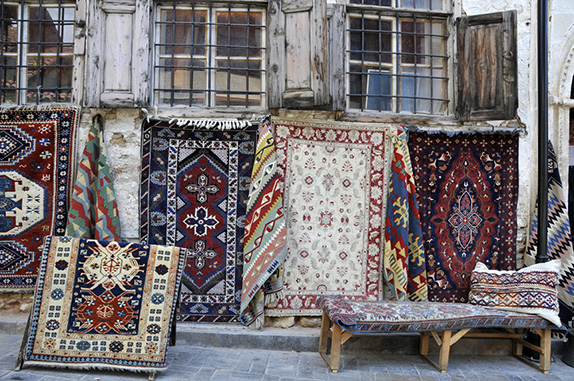 (Open air rug shop, Antalya)
(Open air rug shop, Antalya)
Back in Istanbul, there is no end to exploration and discovery. One may buy a small glass of tea from a street vendor. Or have a cup of strong Turkish coffee at one of the cafes overlooking the Golden Horn, where world-renown writers have sipped coffee in decades past. One may spend hours in the narrow lanes of the city’s famous spice market, or visit such landmarks as vast Topkapi Palace, the Blue Mosque, or Hagia Sophia. Neither hours nor days are enough to thoroughly get to know any one of these places. Out of the way, and much less visited, is a church called Chora, where some of the most extraordinary ceiling mosaics may be viewed: the whole history of Christ’s life in tiny pieces of cut stone.
 (Spice market, Istanbul)
(Spice market, Istanbul)
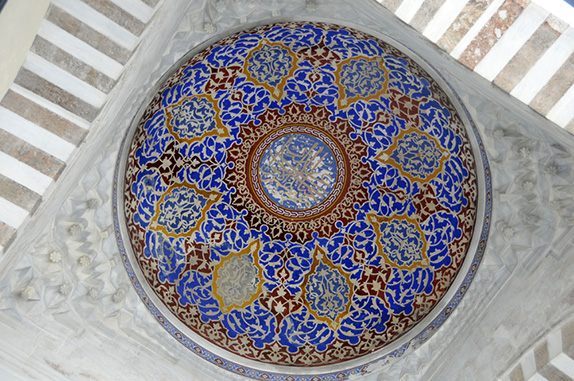 (Detail in Blue Mosque, Istanbul)
(Detail in Blue Mosque, Istanbul)
We split our time in Turkey between overland exploration of cities and countryside, and taking a small gulet called the Doruk Reisa down the Turquoise Coast. A gulet is a sailboat with a motor, small in size but large in hospitality. Rudimentary cabins could be stuffy at night. The food was local and wholesome. The charm of such a voyage was the utter lack of T-shirt shops filled with tourists one encounters when sailing among the Greek Isles, to Montenegro, or other parts of the Mediterranean. Here it is all clean water and brilliant sky. Occasionally another gulet can be seen along the coast or entering a marsh-filled tributary. Lycian tombs are carved into rock walls, and small Lycian and Roman ruins dot the shore.
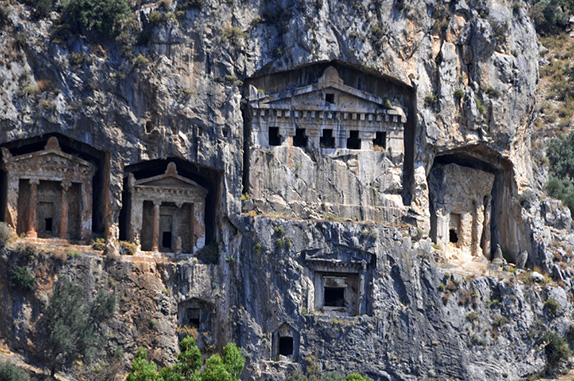 (Lycian tombs carved into the cliff)
(Lycian tombs carved into the cliff)
Cleopatra is said to have enjoyed this coast. We stopped at one of her baths, a ruin of gray stone on a small promontory. I wandered from room to room, conscious of how completely this space has changed since the Egyptian queen spent time here, even though she must have looked out at a similar seascape. For a woman who married two of her brothers, had children by at least three different men, was renown for her beauty, and committed suicide by clasping a cobra to her breast before her fortieth birthday, place held a very different meaning than it does for us today. Or maybe not. In any case, her relationship to this place could not have been the same because her life was so different.
I returned to the gulet and spent the afternoon staring at that little ruin, trying to fathom its secrets. Barbara took a kayak and paddled to a nearby coastal community, a smattering of houses and a couple of shops. She managed to make herself understood enough to get her hair cut at an outdoor barber shop, also looking out to sea.

June 21, 2013